Attached files
| file | filename |
|---|---|
| EX-99.1 - EXHIBIT 99.1 - TCF FINANCIAL CORP | tcf63018form8-kexhibit991r.htm |
| 8-K - 8-K - TCF FINANCIAL CORP | tcf63018form8-kearningsrel.htm |
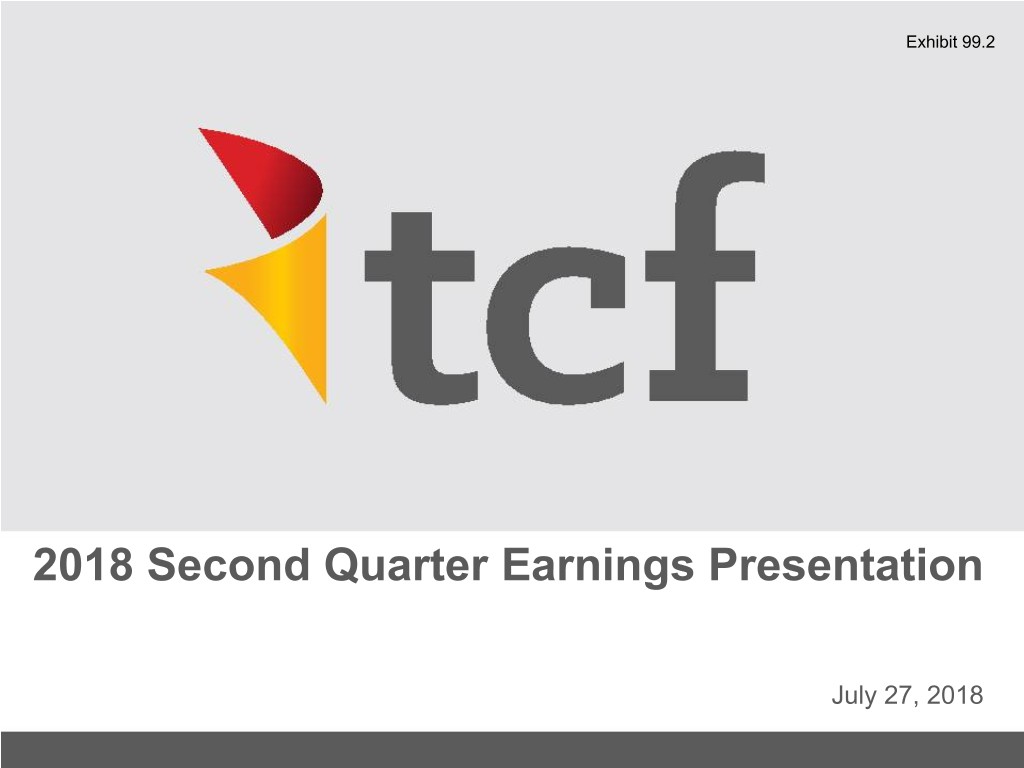
2018 Second Quarter Earnings Presentation July 27, 2018
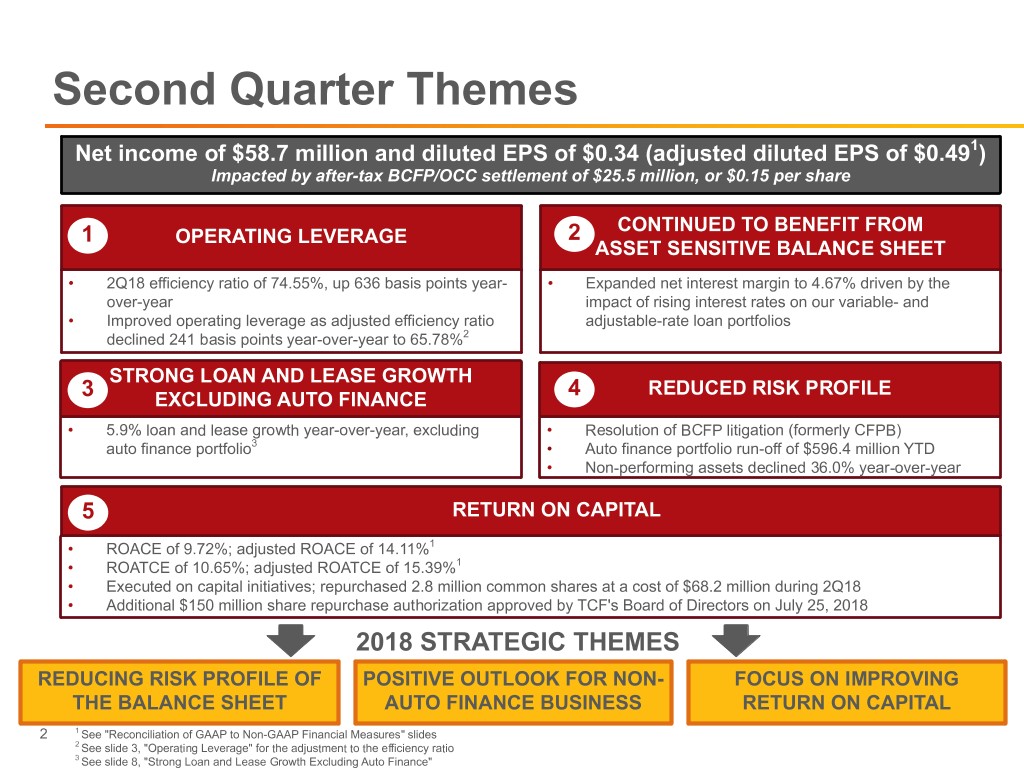
Second Quarter Themes Net income of $58.7 million and diluted EPS of $0.34 (adjusted diluted EPS of $0.491) Impacted by after-tax BCFP/OCC settlement of $25.5 million, or $0.15 per share CONTINUED TO BENEFIT FROM 1 OPERATING LEVERAGE 2 ASSET SENSITIVE BALANCE SHEET • 2Q18 efficiency ratio of 74.55%, up 636 basis points year- • Expanded net interest margin to 4.67% driven by the over-year impact of rising interest rates on our variable- and • Improved operating leverage as adjusted efficiency ratio adjustable-rate loan portfolios declined 241 basis points year-over-year to 65.78%2 STRONG LOAN AND LEASE GROWTH 4 REDUCED RISK PROFILE 3 EXCLUDING AUTO FINANCE • 5.9% loan and lease growth year-over-year, excluding • Resolution of BCFP litigation (formerly CFPB) auto finance portfolio3 • Auto finance portfolio run-off of $596.4 million YTD • Non-performing assets declined 36.0% year-over-year 5 RETURN ON CAPITAL • ROACE of 9.72%; adjusted ROACE of 14.11%1 • ROATCE of 10.65%; adjusted ROATCE of 15.39%1 • Executed on capital initiatives; repurchased 2.8 million common shares at a cost of $68.2 million during 2Q18 • Additional $150 million share repurchase authorization approved by TCF's Board of Directors on July 25, 2018 2018 STRATEGIC THEMES REDUCING RISK PROFILE OF POSITIVE OUTLOOK FOR NON- FOCUS ON IMPROVING THE BALANCE SHEET AUTO FINANCE BUSINESS RETURN ON CAPITAL 2 1 See "Reconciliation of GAAP to Non-GAAP Financial Measures" slides 2 See slide 3, "Operating Leverage" for the adjustment to the efficiency ratio 3 See slide 8, "Strong Loan and Lease Growth Excluding Auto Finance"
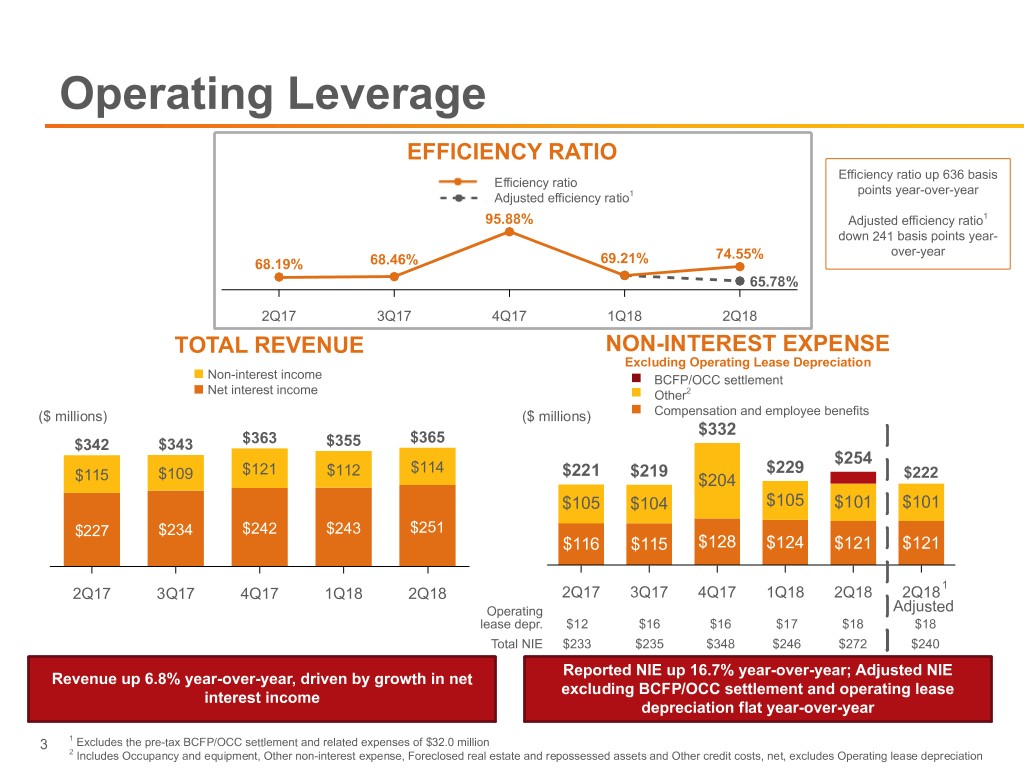
Up 6.8% YoY Operating Leverage EFFICIENCY RATIO Efficiency ratio up 636 basis Efficiency ratio points year-over-year Adjusted efficiency ratio1 95.88% Adjusted efficiency ratio1 down 241 basis points year- 74.55% over-year 68.19% 68.46% 69.21% 65.78% 2Q17 3Q17 4Q17 1Q18 2Q18 TOTAL REVENUE NON-INTEREST EXPENSE Excluding Operating Lease Depreciation Non-interest income ` BCFP/OCC settlement Net interest income Other2 ($ millions) ($ millions) Compensation and employee benefits $332 $342 $343 $363 $355 $365 $254 $121 $112 $114 $221 $219 $229 $115 $109 $204 $222 $105 $104 $105 $101 $101 $227 $234 $242 $243 $251 $116 $115 $128 $124 $121 $121 1 2Q17 3Q17 4Q17 1Q18 2Q18 2Q17 3Q17 4Q17 1Q18 2Q18 2Q18 Operating Adjusted lease depr. $12 $16 $16 $17 $18 $18 Total NIE $233 $235 $348 $246 $272 $240 Reported NIE up 16.7% year-over-year; Adjusted NIE Revenue up 6.8% year-over-year, driven by growth in net excluding BCFP/OCC settlement and operating lease interest income depreciation flat year-over-year 3 1 Excludes the pre-tax BCFP/OCC settlement and related expenses of $32.0 million 2 Includes Occupancy and equipment, Other non-interest expense, Foreclosed real estate and repossessed assets and Other credit costs, net, excludes Operating lease depreciation
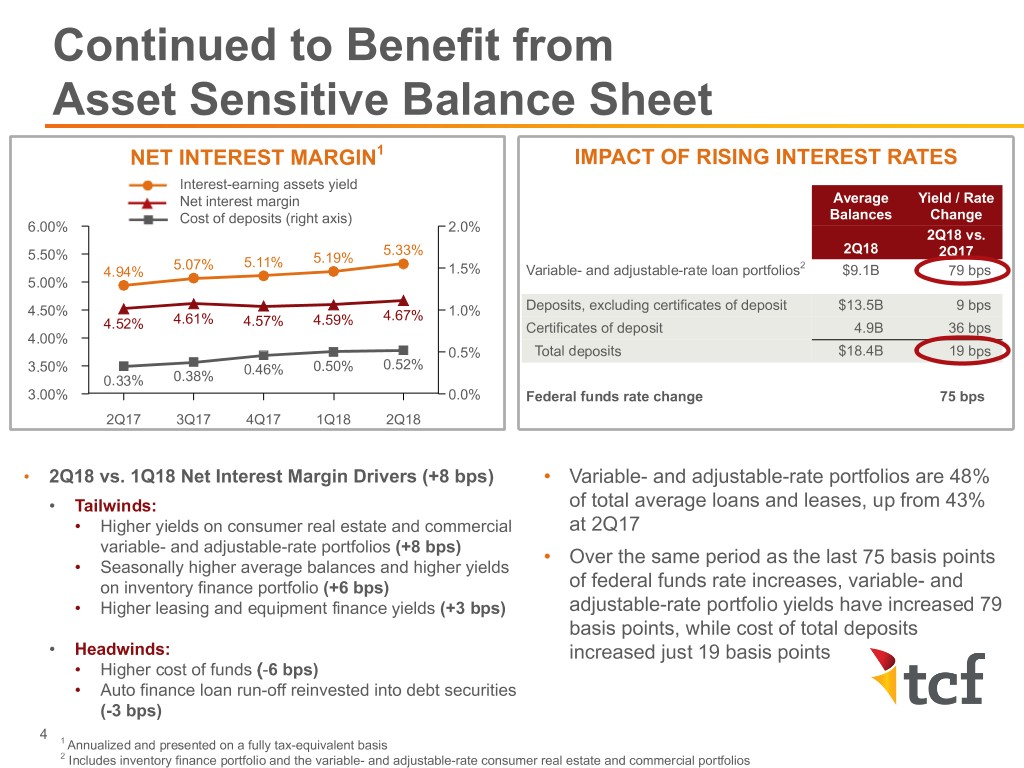
Continued to Benefit from Asset Sensitive Balance Sheet NET INTEREST MARGIN1 IMPACT OF RISING INTEREST RATES Interest-earning assets yield Net interest margin Average Yield / Rate Cost of deposits (right axis) Balances Change 6.00% 2.0% 2Q18 vs. 5.33% 2Q18 5.50% 5.19% 2Q17 5.07% 5.11% 2 4.94% 1.5% Variable- and adjustable-rate loan portfolios $9.1B 79 bps 5.00% 4.50% 1.0% Deposits, excluding certificates of deposit $13.5B 9 bps 4.61% 4.59% 4.67% 4.52% 4.57% Certificates of deposit 4.9B 36 bps 4.00% 0.5% Total deposits $18.4B 19 bps 3.50% 0.46% 0.50% 0.52% 0.33% 0.38% 3.00% 0.0% Federal funds rate change 75 bps 2Q17 3Q17 4Q17 1Q18 2Q18 • 2Q18 vs. 1Q18 Net Interest Margin Drivers (+8 bps) • Variable- and adjustable-rate portfolios are 48% • Tailwinds: of total average loans and leases, up from 43% • Higher yields on consumer real estate and commercial at 2Q17 variable- and adjustable-rate portfolios (+8 bps) • Over the same period as the last 75 basis points • Seasonally higher average balances and higher yields on inventory finance portfolio (+6 bps) of federal funds rate increases, variable- and • Higher leasing and equipment finance yields (+3 bps) adjustable-rate portfolio yields have increased 79 basis points, while cost of total deposits • Headwinds: increased just 19 basis points • Higher cost of funds (-6 bps) • Auto finance loan run-off reinvested into debt securities (-3 bps) 4 1 Annualized and presented on a fully tax-equivalent basis 2 Includes inventory finance portfolio and the variable- and adjustable-rate consumer real estate and commercial portfolios
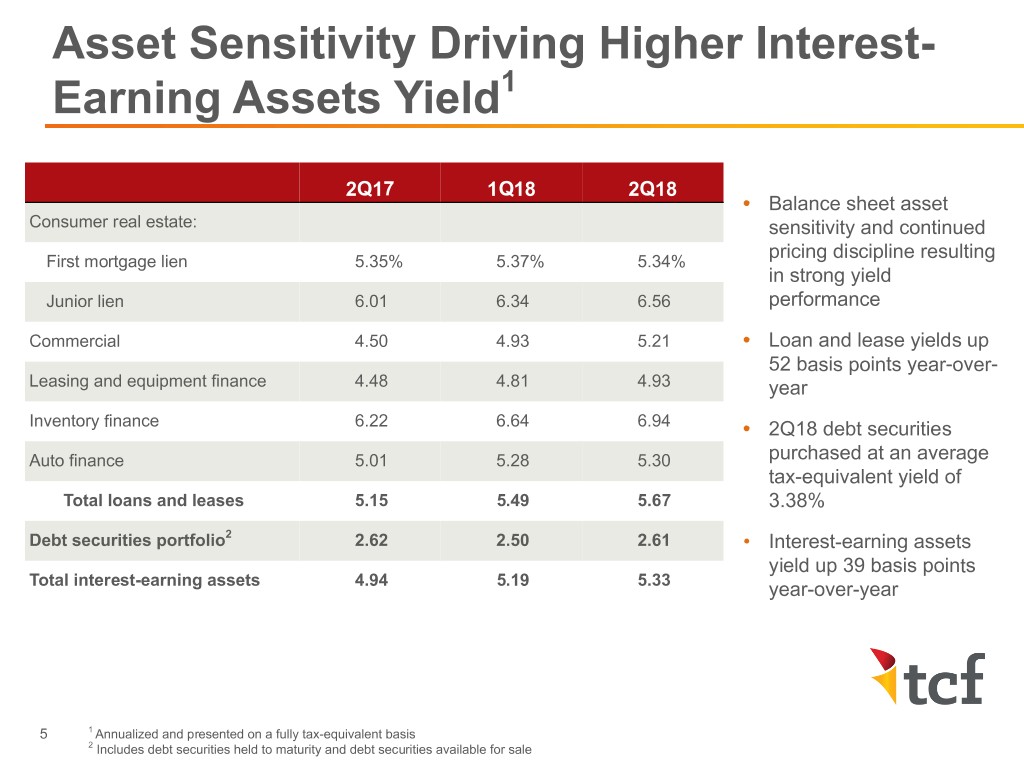
Asset Sensitivity Driving Higher Interest- Earning Assets Yield1 2Q17 1Q18 2Q18 • Balance sheet asset Consumer real estate: sensitivity and continued pricing discipline resulting First mortgage lien 5.35% 5.37% 5.34% in strong yield Junior lien 6.01 6.34 6.56 performance Commercial 4.50 4.93 5.21 • Loan and lease yields up 52 basis points year-over- Leasing and equipment finance 4.48 4.81 4.93 year Inventory finance 6.22 6.64 6.94 • 2Q18 debt securities Auto finance 5.01 5.28 5.30 purchased at an average tax-equivalent yield of Total loans and leases 5.15 5.49 5.67 3.38% Debt securities portfolio2 2.62 2.50 2.61 • Interest-earning assets yield up 39 basis points Total interest-earning assets 4.94 5.19 5.33 year-over-year 5 1 Annualized and presented on a fully tax-equivalent basis 2 Includes debt securities held to maturity and debt securities available for sale
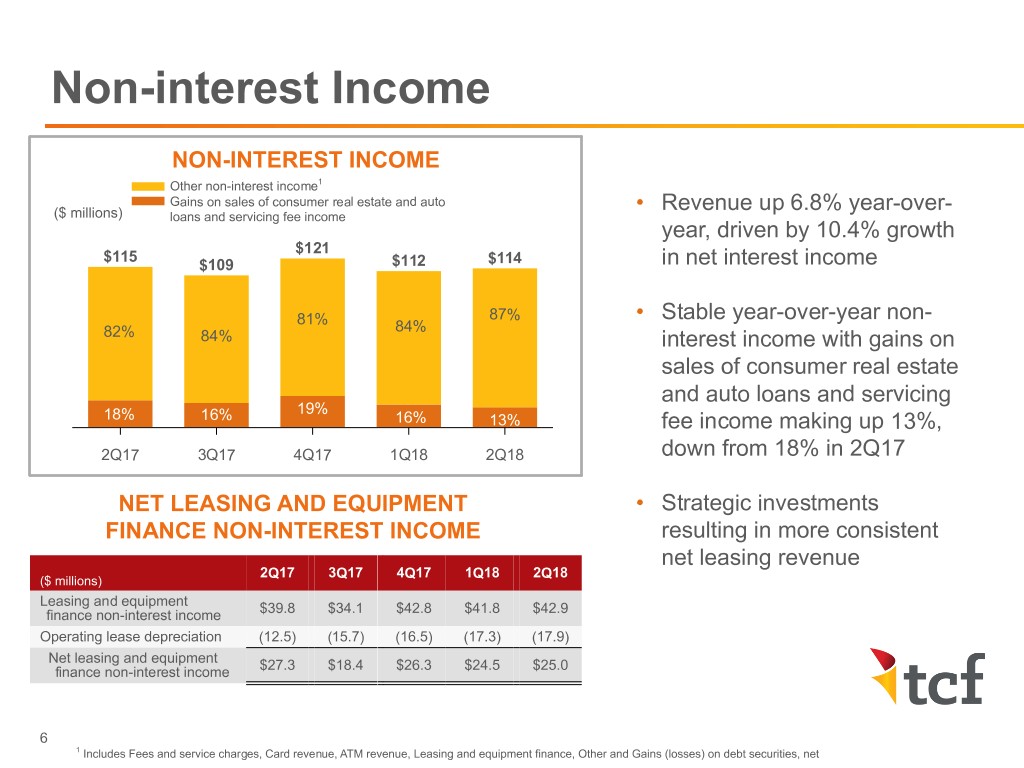
Non-interest Income NON-INTEREST INCOME Other non-interest income1 Gains on sales of consumer real estate and auto • Revenue up 6.8% year-over- ($ millions) loans and servicing fee income year, driven by 10.4% growth $121 $115 $109 $112 $114 in net interest income 87% • Stable year-over-year non- 81% 84% 82% 84% interest income with gains on sales of consumer real estate and auto loans and servicing 19% 18% 16% 16% 13% fee income making up 13%, 2Q17 3Q17 4Q17 1Q18 2Q18 down from 18% in 2Q17 NET LEASING AND EQUIPMENT • Strategic investments FINANCE NON-INTEREST INCOME resulting in more consistent net leasing revenue 2Q17 3Q17 4Q17 1Q18 2Q18 ($ millions) Leasing and equipment finance non-interest income $39.8 $34.1 $42.8 $41.8 $42.9 Operating lease depreciation (12.5) (15.7) (16.5) (17.3) (17.9) Net leasing and equipment finance non-interest income $27.3 $18.4 $26.3 $24.5 $25.0 6 1 Includes Fees and service charges, Card revenue, ATM revenue, Leasing and equipment finance, Other and Gains (losses) on debt securities, net
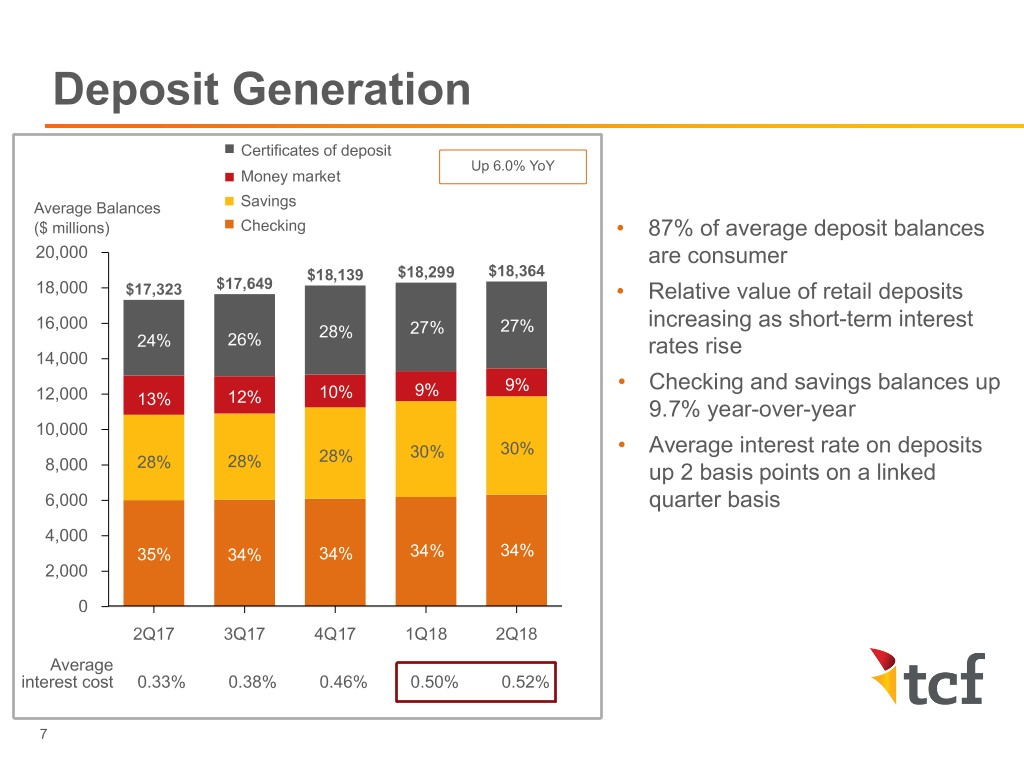
Deposit Generation Certificates of deposit Up 6.0% YoY Money market Average Balances Savings ($ millions) Checking • 87% of average deposit balances 20,000 are consumer $18,139 $18,299 $18,364 18,000 $17,323 $17,649 • Relative value of retail deposits 16,000 increasing as short-term interest 28% 27% 27% 24% 26% rates rise 14,000 9% • Checking and savings balances up 12,000 12% 10% 9% 13% 9.7% year-over-year 10,000 28% 30% 30% • Average interest rate on deposits 8,000 28% 28% up 2 basis points on a linked 6,000 quarter basis 4,000 35% 34% 34% 34% 34% 2,000 0 2Q17 3Q17 4Q17 1Q18 2Q18 Average interest cost 0.33% 0.38% 0.46% 0.50% 0.52% 7
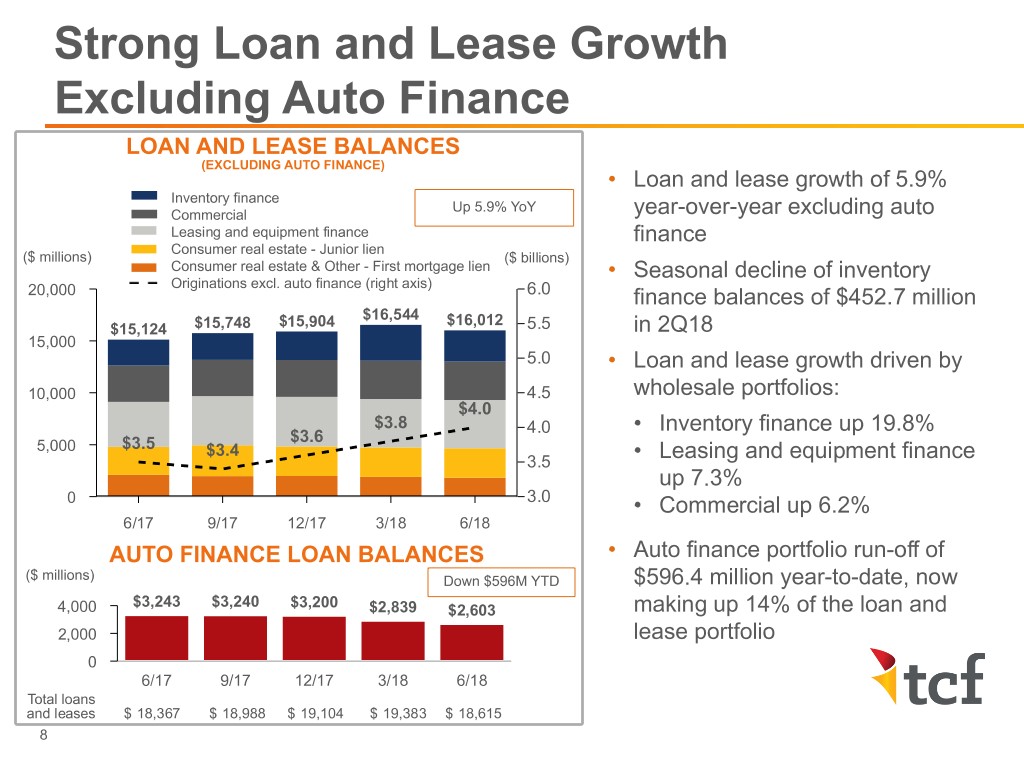
Strong Loan and Lease Growth Excluding Auto Finance LOAN AND LEASE BALANCES (EXCLUDING AUTO FINANCE) • Loan and lease growth of 5.9% Inventory finance Up 5.9% YoY Commercial year-over-year excluding auto Leasing and equipment finance finance Consumer real estate - Junior lien ($ millions) ($ billions) Consumer real estate & Other - First mortgage lien • Seasonal decline of inventory Originations excl. auto finance (right axis) 20,000 6.0 finance balances of $452.7 million $15,904 $16,544 $16,012 $15,124 $15,748 5.5 in 2Q18 15,000 5.0 • Loan and lease growth driven by 10,000 4.5 wholesale portfolios: $4.0 $3.8 4.0 • Inventory finance up 19.8% $3.6 5,000 $3.5 $3.4 3.5 • Leasing and equipment finance up 7.3% 0 3.0 • Commercial up 6.2% 6/17 9/17 12/17 3/18 6/18 AUTO FINANCE LOAN BALANCES • Auto finance portfolio run-off of ($ millions) Down $596M YTD $596.4 million year-to-date, now $3,243 $3,240 $3,200 4,000 $2,839 $2,603 making up 14% of the loan and 2,000 lease portfolio 0 6/17 9/17 12/17 3/18 6/18 Total loans and leases $ 18,367 $ 18,988 $ 19,104 $ 19,383 $ 18,615 8
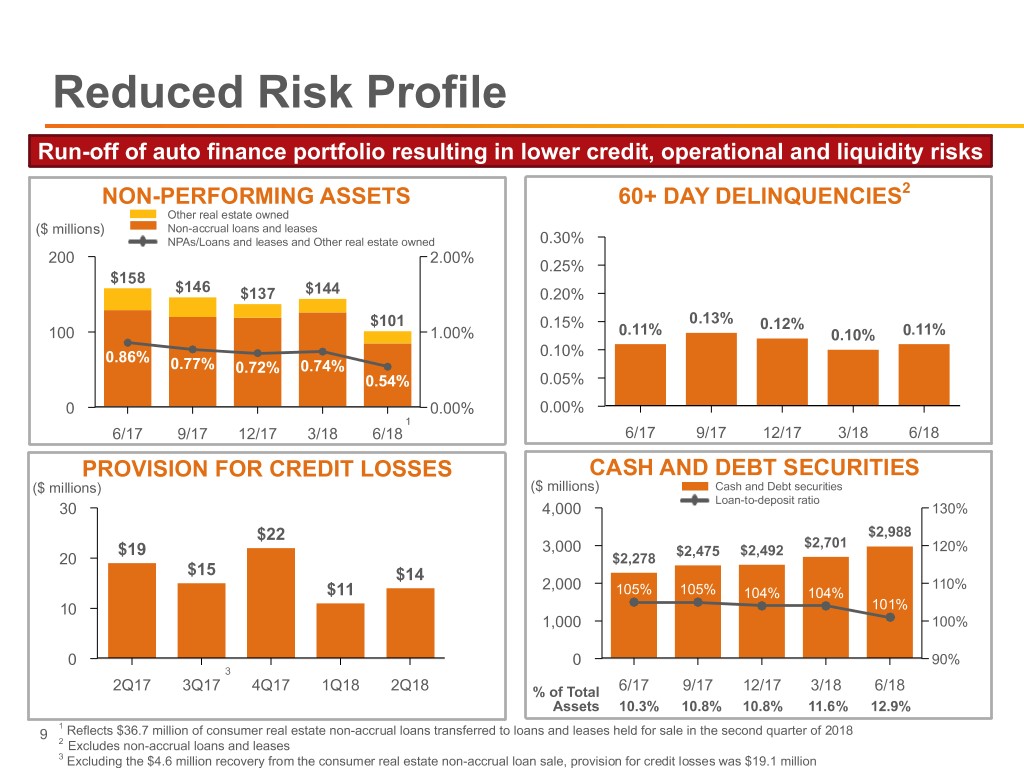
Reduced Risk Profile Run-off of auto finance portfolio resulting in lower credit, operational and liquidity risks NON-PERFORMING ASSETS 60+ DAY DELINQUENCIES2 Other real estate owned ($ millions) Non-accrual loans and leases NPAs/Loans and leases and Other real estate owned 0.30% 200 2.00% 0.25% $158 $146 $137 $144 0.20% $101 0.15% 0.13% 0.12% 100 1.00% 0.11% 0.10% 0.11% 0.86% 0.10% 0.77% 0.72% 0.74% 0.54% 0.05% 0 0.00% 0.00% 1 6/17 9/17 12/17 3/18 6/18 6/17 9/17 12/17 3/18 6/18 PROVISION FOR CREDIT LOSSES CASH AND DEBT SECURITIES ($ millions) ($ millions) Cash and Debt securities Loan-to-deposit ratio 30 4,000 130% $2,988 $22 $2,701 $19 3,000 $2,475 $2,492 120% 20 $2,278 2 $15 $14 2,000 110% $11 105% 105% 104% 104% 10 101% 1,000 100% 0 0 90% 3 2Q17 3Q17 4Q17 1Q18 2Q18 % of Total 6/17 9/17 12/17 3/18 6/18 Assets 10.3% 10.8% 10.8% 11.6% 12.9% 1 9 Reflects $36.7 million of consumer real estate non-accrual loans transferred to loans and leases held for sale in the second quarter of 2018 2 Excludes non-accrual loans and leases 3 Excluding the $4.6 million recovery from the consumer real estate non-accrual loan sale, provision for credit losses was $19.1 million
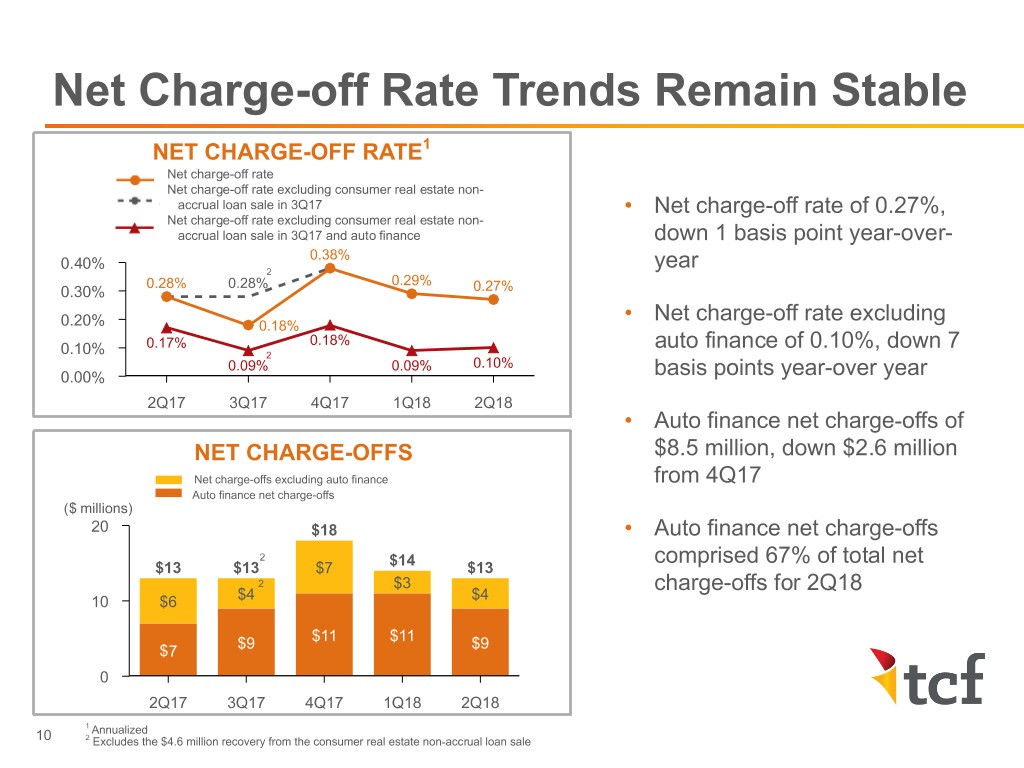
Net Charge-off Rate Trends Remain Stable 1 NET CHARGE-OFF RATE 4 Net charge-off rate Net charge-off rate excluding consumer real estate non- accrual4 loan sale in 3Q17 • Net charge-off rate of 0.27%, Net charge-off rate excluding consumer real estate non- accrual loan sale in 3Q17 and auto finance down 1 basis point year-over- 0.38% 0.40% 2 year 0.28% 0.28% 0.29% 0.30% 0.27% • Net charge-off rate excluding 0.20% 0.18% 0.17% 0.18% auto finance of 0.10%, down 7 0.10% 2 0.09% 0.09% 0.10% 0.00% basis points year-over year 2Q17 3Q17 4Q17 1Q18 2Q18 • Auto finance net charge-offs of NET CHARGE-OFFS $8.5 million, down $2.6 million Net charge-offs excluding auto finance from 4Q17 Auto finance net charge-offs ($ millions) 20 $18 • Auto finance net charge-offs 2 comprised 67% of total net $13 $13 $7 $14 $13 2 $3 charge-offs for 2Q18 10 $6 $4 $4 $11 $11 $7 $9 $9 0 2Q17 3Q17 4Q17 1Q18 2Q18 1 Annualized 10 2 Excludes the $4.6 million recovery from the consumer real estate non-accrual loan sale
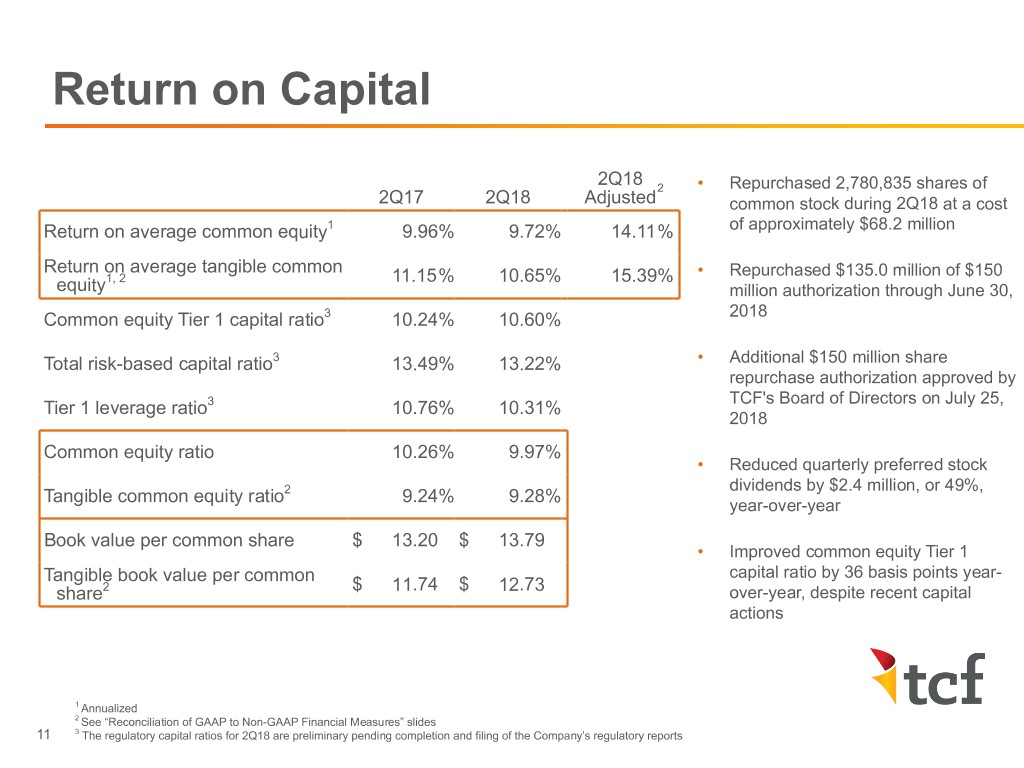
Return on Capital 2Q18 2 • Repurchased 2,780,835 shares of 2Q17 2Q18 Adjusted common stock during 2Q18 at a cost Return on average common equity1 9.96% 9.72% 14.11% of approximately $68.2 million Return on average tangible common 1, 2 11.15% 10.65% 15.39% • Repurchased $135.0 million of $150 equity million authorization through June 30, Common equity Tier 1 capital ratio3 10.24% 10.60% 2018 Total risk-based capital ratio3 13.49% 13.22% • Additional $150 million share repurchase authorization approved by TCF's Board of Directors on July 25, Tier 1 leverage ratio3 10.76% 10.31% 2018 Common equity ratio 10.26% 9.97% • Reduced quarterly preferred stock dividends by $2.4 million, or 49%, Tangible common equity ratio2 9.24% 9.28% year-over-year Book value per common share $ 13.20 $ 13.79 • Improved common equity Tier 1 Tangible book value per common capital ratio by 36 basis points year- 2 $ $ share 11.74 12.73 over-year, despite recent capital actions 1 Annualized 2 See “Reconciliation of GAAP to Non-GAAP Financial Measures” slides 11 3 The regulatory capital ratios for 2Q18 are preliminary pending completion and filing of the Company’s regulatory reports
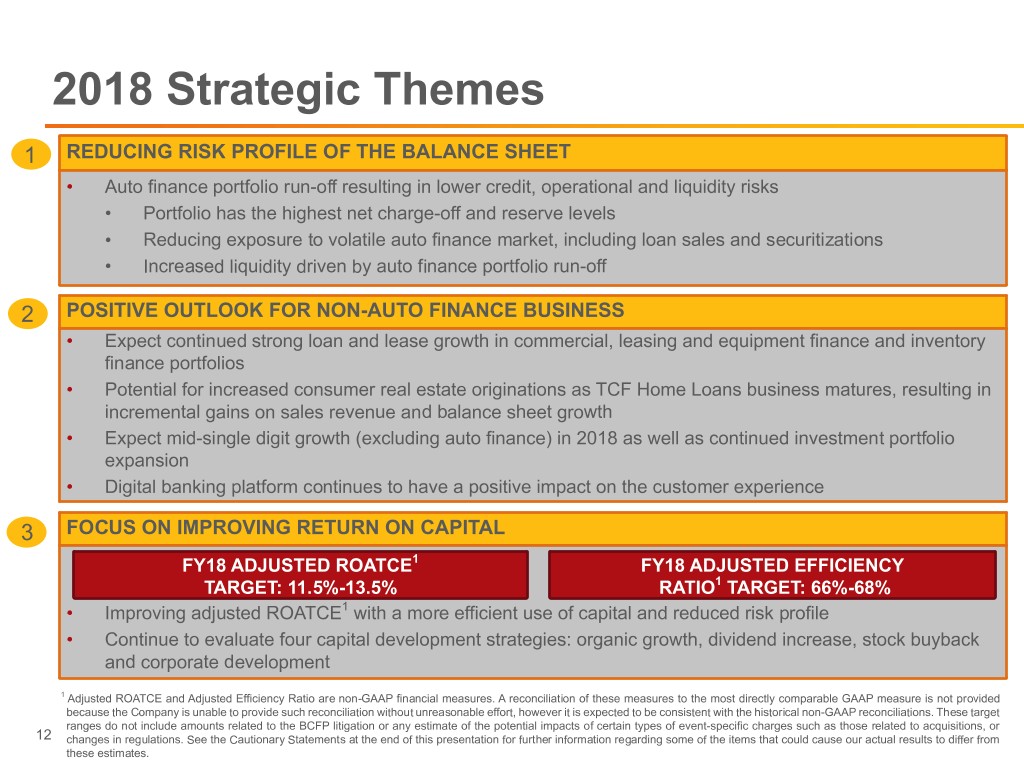
2018 Strategic Themes 1 REDUCING RISK PROFILE OF THE BALANCE SHEET • Auto finance portfolio run-off resulting in lower credit, operational and liquidity risks • Portfolio has the highest net charge-off and reserve levels • Reducing exposure to volatile auto finance market, including loan sales and securitizations • Increased liquidity driven by auto finance portfolio run-off 2 POSITIVE OUTLOOK FOR NON-AUTO FINANCE BUSINESS • Expect continued strong loan and lease growth in commercial, leasing and equipment finance and inventory finance portfolios • Potential for increased consumer real estate originations as TCF Home Loans business matures, resulting in incremental gains on sales revenue and balance sheet growth • Expect mid-single digit growth (excluding auto finance) in 2018 as well as continued investment portfolio expansion • Digital banking platform continues to have a positive impact on the customer experience 3 FOCUS ON IMPROVING RETURN ON CAPITAL FY18 ADJUSTED ROATCE1 FY18 ADJUSTED EFFICIENCY TARGET: 11.5%-13.5% RATIO1 TARGET: 66%-68% • Improving adjusted ROATCE1 with a more efficient use of capital and reduced risk profile • Continue to evaluate four capital development strategies: organic growth, dividend increase, stock buyback and corporate development 1 Adjusted ROATCE and Adjusted Efficiency Ratio are non-GAAP financial measures. A reconciliation of these measures to the most directly comparable GAAP measure is not provided because the Company is unable to provide such reconciliation without unreasonable effort, however it is expected to be consistent with the historical non-GAAP reconciliations. These target ranges do not include amounts related to the BCFP litigation or any estimate of the potential impacts of certain types of event-specific charges such as those related to acquisitions, or 12 changes in regulations. See the Cautionary Statements at the end of this presentation for further information regarding some of the items that could cause our actual results to differ from these estimates.

Appendix
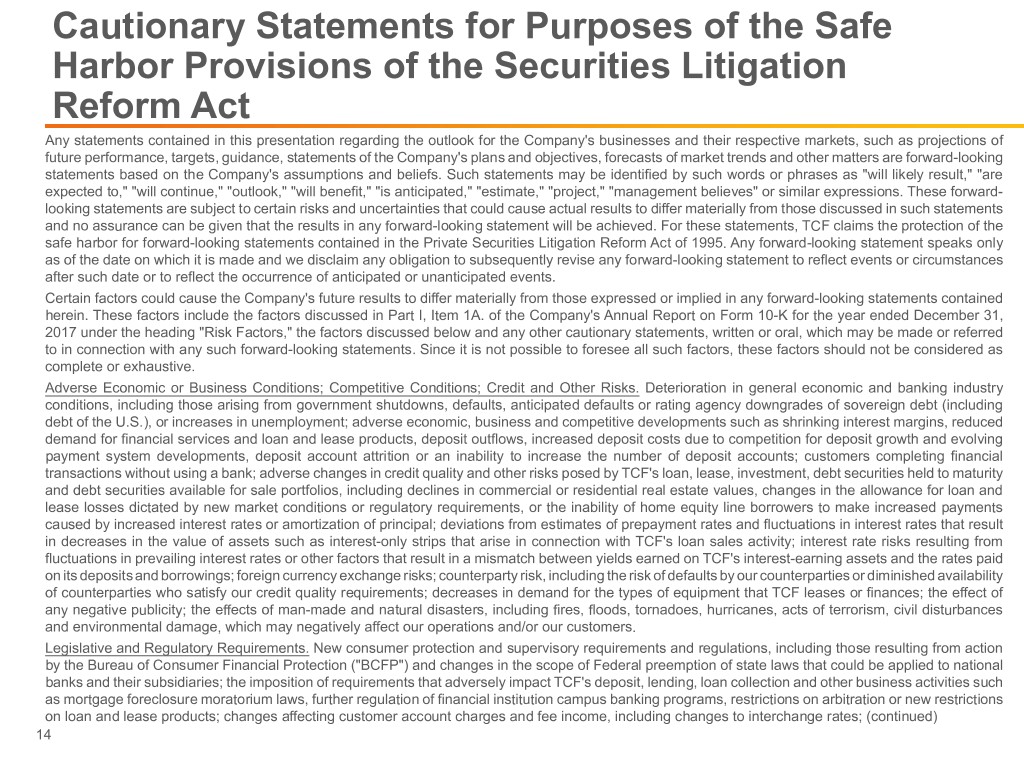
Cautionary Statements for Purposes of the Safe Harbor Provisions of the Securities Litigation Reform Act Any statements contained in this presentation regarding the outlook for the Company's businesses and their respective markets, such as projections of future performance, targets, guidance, statements of the Company's plans and objectives, forecasts of market trends and other matters are forward-looking statements based on the Company's assumptions and beliefs. Such statements may be identified by such words or phrases as "will likely result," "are expected to," "will continue," "outlook," "will benefit," "is anticipated," "estimate," "project," "management believes" or similar expressions. These forward- looking statements are subject to certain risks and uncertainties that could cause actual results to differ materially from those discussed in such statements and no assurance can be given that the results in any forward-looking statement will be achieved. For these statements, TCF claims the protection of the safe harbor for forward-looking statements contained in the Private Securities Litigation Reform Act of 1995. Any forward-looking statement speaks only as of the date on which it is made and we disclaim any obligation to subsequently revise any forward-looking statement to reflect events or circumstances after such date or to reflect the occurrence of anticipated or unanticipated events. Certain factors could cause the Company's future results to differ materially from those expressed or implied in any forward-looking statements contained herein. These factors include the factors discussed in Part I, Item 1A. of the Company's Annual Report on Form 10-K for the year ended December 31, 2017 under the heading "Risk Factors," the factors discussed below and any other cautionary statements, written or oral, which may be made or referred to in connection with any such forward-looking statements. Since it is not possible to foresee all such factors, these factors should not be considered as complete or exhaustive. Adverse Economic or Business Conditions; Competitive Conditions; Credit and Other Risks. Deterioration in general economic and banking industry conditions, including those arising from government shutdowns, defaults, anticipated defaults or rating agency downgrades of sovereign debt (including debt of the U.S.), or increases in unemployment; adverse economic, business and competitive developments such as shrinking interest margins, reduced demand for financial services and loan and lease products, deposit outflows, increased deposit costs due to competition for deposit growth and evolving payment system developments, deposit account attrition or an inability to increase the number of deposit accounts; customers completing financial transactions without using a bank; adverse changes in credit quality and other risks posed by TCF's loan, lease, investment, debt securities held to maturity and debt securities available for sale portfolios, including declines in commercial or residential real estate values, changes in the allowance for loan and lease losses dictated by new market conditions or regulatory requirements, or the inability of home equity line borrowers to make increased payments caused by increased interest rates or amortization of principal; deviations from estimates of prepayment rates and fluctuations in interest rates that result in decreases in the value of assets such as interest-only strips that arise in connection with TCF's loan sales activity; interest rate risks resulting from fluctuations in prevailing interest rates or other factors that result in a mismatch between yields earned on TCF's interest-earning assets and the rates paid on its deposits and borrowings; foreign currency exchange risks; counterparty risk, including the risk of defaults by our counterparties or diminished availability of counterparties who satisfy our credit quality requirements; decreases in demand for the types of equipment that TCF leases or finances; the effect of any negative publicity; the effects of man-made and natural disasters, including fires, floods, tornadoes, hurricanes, acts of terrorism, civil disturbances and environmental damage, which may negatively affect our operations and/or our customers. Legislative and Regulatory Requirements. New consumer protection and supervisory requirements and regulations, including those resulting from action by the Bureau of Consumer Financial Protection ("BCFP") and changes in the scope of Federal preemption of state laws that could be applied to national banks and their subsidiaries; the imposition of requirements that adversely impact TCF's deposit, lending, loan collection and other business activities such as mortgage foreclosure moratorium laws, further regulation of financial institution campus banking programs, restrictions on arbitration or new restrictions on loan and lease products; changes affecting customer account charges and fee income, including changes to interchange rates; (continued) 14
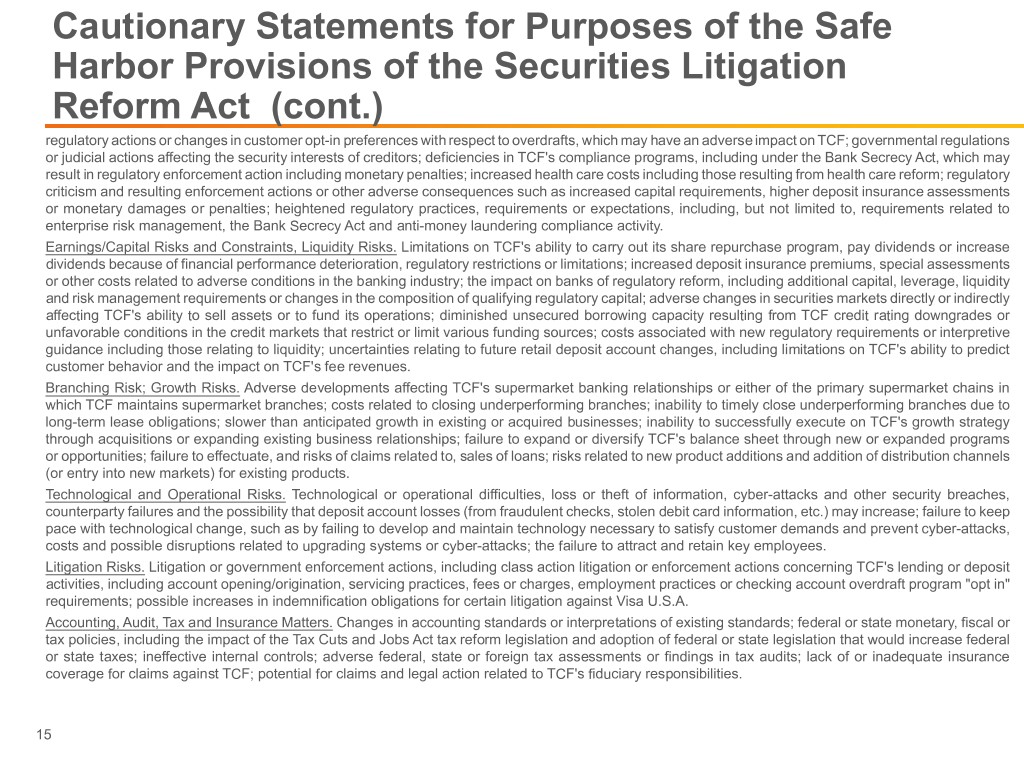
Cautionary Statements for Purposes of the Safe Harbor Provisions of the Securities Litigation Reform Act (cont.) regulatory actions or changes in customer opt-in preferences with respect to overdrafts, which may have an adverse impact on TCF; governmental regulations or judicial actions affecting the security interests of creditors; deficiencies in TCF's compliance programs, including under the Bank Secrecy Act, which may result in regulatory enforcement action including monetary penalties; increased health care costs including those resulting from health care reform; regulatory criticism and resulting enforcement actions or other adverse consequences such as increased capital requirements, higher deposit insurance assessments or monetary damages or penalties; heightened regulatory practices, requirements or expectations, including, but not limited to, requirements related to enterprise risk management, the Bank Secrecy Act and anti-money laundering compliance activity. Earnings/Capital Risks and Constraints, Liquidity Risks. Limitations on TCF's ability to carry out its share repurchase program, pay dividends or increase dividends because of financial performance deterioration, regulatory restrictions or limitations; increased deposit insurance premiums, special assessments or other costs related to adverse conditions in the banking industry; the impact on banks of regulatory reform, including additional capital, leverage, liquidity and risk management requirements or changes in the composition of qualifying regulatory capital; adverse changes in securities markets directly or indirectly affecting TCF's ability to sell assets or to fund its operations; diminished unsecured borrowing capacity resulting from TCF credit rating downgrades or unfavorable conditions in the credit markets that restrict or limit various funding sources; costs associated with new regulatory requirements or interpretive guidance including those relating to liquidity; uncertainties relating to future retail deposit account changes, including limitations on TCF's ability to predict customer behavior and the impact on TCF's fee revenues. Branching Risk; Growth Risks. Adverse developments affecting TCF's supermarket banking relationships or either of the primary supermarket chains in which TCF maintains supermarket branches; costs related to closing underperforming branches; inability to timely close underperforming branches due to long-term lease obligations; slower than anticipated growth in existing or acquired businesses; inability to successfully execute on TCF's growth strategy through acquisitions or expanding existing business relationships; failure to expand or diversify TCF's balance sheet through new or expanded programs or opportunities; failure to effectuate, and risks of claims related to, sales of loans; risks related to new product additions and addition of distribution channels (or entry into new markets) for existing products. Technological and Operational Risks. Technological or operational difficulties, loss or theft of information, cyber-attacks and other security breaches, counterparty failures and the possibility that deposit account losses (from fraudulent checks, stolen debit card information, etc.) may increase; failure to keep pace with technological change, such as by failing to develop and maintain technology necessary to satisfy customer demands and prevent cyber-attacks, costs and possible disruptions related to upgrading systems or cyber-attacks; the failure to attract and retain key employees. Litigation Risks. Litigation or government enforcement actions, including class action litigation or enforcement actions concerning TCF's lending or deposit activities, including account opening/origination, servicing practices, fees or charges, employment practices or checking account overdraft program "opt in" requirements; possible increases in indemnification obligations for certain litigation against Visa U.S.A. Accounting, Audit, Tax and Insurance Matters. Changes in accounting standards or interpretations of existing standards; federal or state monetary, fiscal or tax policies, including the impact of the Tax Cuts and Jobs Act tax reform legislation and adoption of federal or state legislation that would increase federal or state taxes; ineffective internal controls; adverse federal, state or foreign tax assessments or findings in tax audits; lack of or inadequate insurance coverage for claims against TCF; potential for claims and legal action related to TCF's fiduciary responsibilities. 15
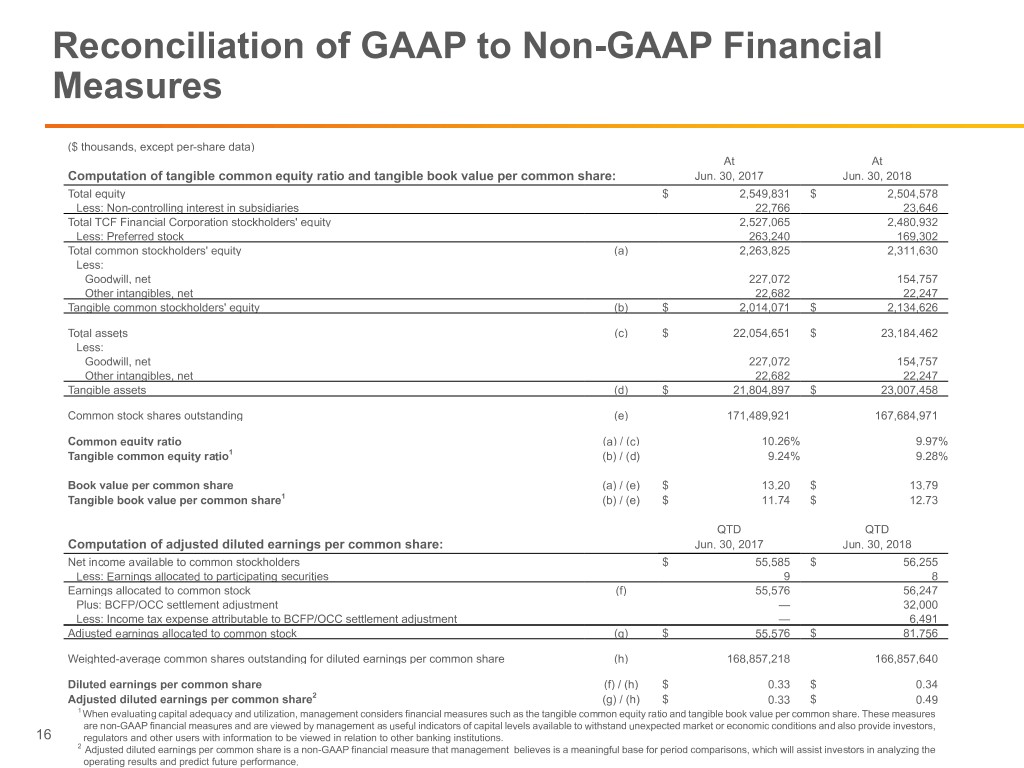
Reconciliation of GAAP to Non-GAAP Financial Measures ($ thousands, except per-share data) At At Computation of tangible common equity ratio and tangible book value per common share: Jun. 30, 2017 Jun. 30, 2018 Total equity $ 2,549,831 $ 2,504,578 Less: Non-controlling interest in subsidiaries 22,766 23,646 Total TCF Financial Corporation stockholders' equity 2,527,065 2,480,932 Less: Preferred stock 263,240 169,302 Total common stockholders' equity (a) 2,263,825 2,311,630 Less: Goodwill, net 227,072 154,757 Other intangibles, net 22,682 22,247 Tangible common stockholders' equity (b) $ 2,014,071 $ 2,134,626 Total assets (c) $ 22,054,651 $ 23,184,462 Less: Goodwill, net 227,072 154,757 Other intangibles, net 22,682 22,247 Tangible assets (d) $ 21,804,897 $ 23,007,458 Common stock shares outstanding (e) 171,489,921 167,684,971 Common equity ratio (a) / (c) 10.26% 9.97% Tangible common equity ratio1 (b) / (d) 9.24% 9.28% Book value per common share (a) / (e) $ 13.20 $ 13.79 Tangible book value per common share1 (b) / (e) $ 11.74 $ 12.73 QTD QTD Computation of adjusted diluted earnings per common share: Jun. 30, 2017 Jun. 30, 2018 Net income available to common stockholders $ 55,585 $ 56,255 Less: Earnings allocated to participating securities 9 8 Earnings allocated to common stock (f) 55,576 56,247 Plus: BCFP/OCC settlement adjustment — 32,000 Less: Income tax expense attributable to BCFP/OCC settlement adjustment — 6,491 Adjusted earnings allocated to common stock (g) $ 55,576 $ 81,756 Weighted-average common shares outstanding for diluted earnings per common share (h) 168,857,218 166,857,640 Diluted earnings per common share (f) / (h) $ 0.33 $ 0.34 Adjusted diluted earnings per common share2 (g) / (h) $ 0.33 $ 0.49 1 When evaluating capital adequacy and utilization, management considers financial measures such as the tangible common equity ratio and tangible book value per common share. These measures are non-GAAP financial measures and are viewed by management as useful indicators of capital levels available to withstand unexpected market or economic conditions and also provide investors, 16 regulators and other users with information to be viewed in relation to other banking institutions. 2 Adjusted diluted earnings per common share is a non-GAAP financial measure that management believes is a meaningful base for period comparisons, which will assist investors in analyzing the operating results and predict future performance.
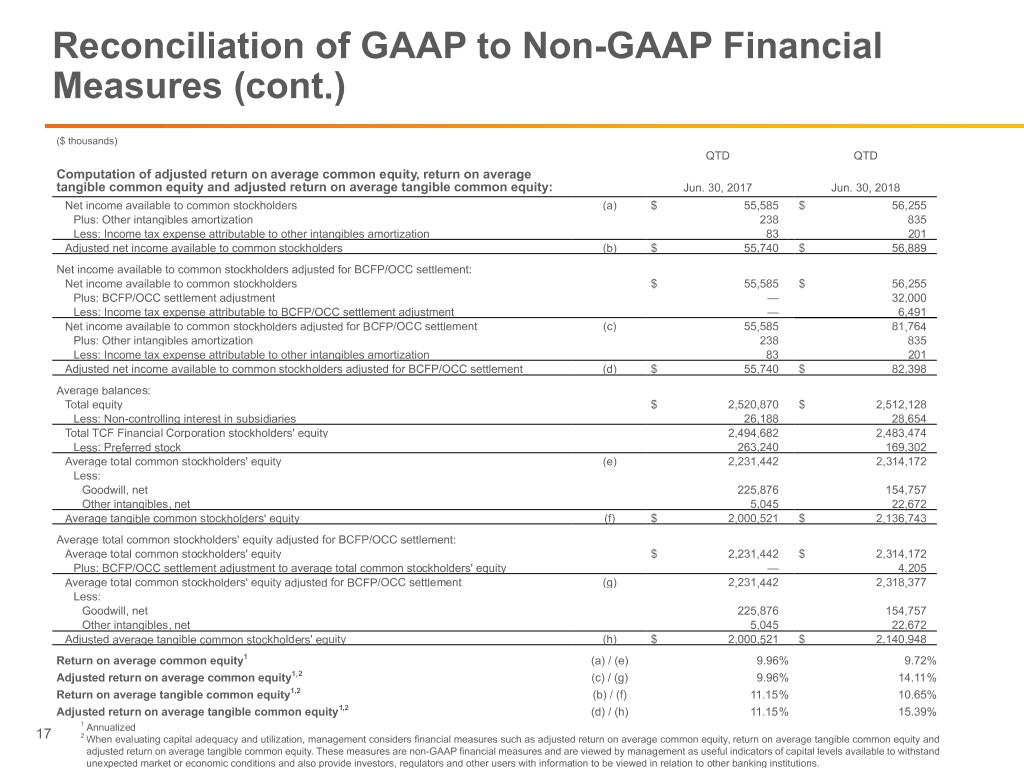
Reconciliation of GAAP to Non-GAAP Financial Measures (cont.) ($ thousands) QTD QTD Computation of adjusted return on average common equity, return on average tangible common equity and adjusted return on average tangible common equity: Jun. 30, 2017 Jun. 30, 2018 Net income available to common stockholders (a) $ 55,585 $ 56,255 Plus: Other intangibles amortization 238 835 Less: Income tax expense attributable to other intangibles amortization 83 201 Adjusted net income available to common stockholders (b) $ 55,740 $ 56,889 Net income available to common stockholders adjusted for BCFP/OCC settlement: Net income available to common stockholders $ 55,585 $ 56,255 Plus: BCFP/OCC settlement adjustment — 32,000 Less: Income tax expense attributable to BCFP/OCC settlement adjustment — 6,491 Net income available to common stockholders adjusted for BCFP/OCC settlement (c) 55,585 81,764 Plus: Other intangibles amortization 238 835 Less: Income tax expense attributable to other intangibles amortization 83 201 Adjusted net income available to common stockholders adjusted for BCFP/OCC settlement (d) $ 55,740 $ 82,398 Average balances: Total equity $ 2,520,870 $ 2,512,128 Less: Non-controlling interest in subsidiaries 26,188 28,654 Total TCF Financial Corporation stockholders' equity 2,494,682 2,483,474 Less: Preferred stock 263,240 169,302 Average total common stockholders' equity (e) 2,231,442 2,314,172 Less: Goodwill, net 225,876 154,757 Other intangibles, net 5,045 22,672 Average tangible common stockholders' equity (f) $ 2,000,521 $ 2,136,743 Average total common stockholders' equity adjusted for BCFP/OCC settlement: Average total common stockholders' equity $ 2,231,442 $ 2,314,172 Plus: BCFP/OCC settlement adjustment to average total common stockholders' equity — 4,205 Average total common stockholders' equity adjusted for BCFP/OCC settlement (g) 2,231,442 2,318,377 Less: Goodwill, net 225,876 154,757 Other intangibles, net 5,045 22,672 Adjusted average tangible common stockholders' equity (h) $ 2,000,521 $ 2,140,948 Return on average common equity1 (a) / (e) 9.96% 9.72% Adjusted return on average common equity1,2 (c) / (g) 9.96% 14.11% Return on average tangible common equity1,2 (b) / (f) 11.15% 10.65% Adjusted return on average tangible common equity1,2 (d) / (h) 11.15% 15.39% 1 Annualized 17 2 When evaluating capital adequacy and utilization, management considers financial measures such as adjusted return on average common equity, return on average tangible common equity and adjusted return on average tangible common equity. These measures are non-GAAP financial measures and are viewed by management as useful indicators of capital levels available to withstand unexpected market or economic conditions and also provide investors, regulators and other users with information to be viewed in relation to other banking institutions.
